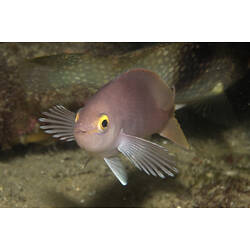General Description
Oval body, rather short head with small mouth, and long-based dorsal fin without a distinct notch. Adult males are bluish with a black bar on the side. Females are pinkish with a blue line below the eye. Small juveniles are pink to pinkish-orange with a dark mauve head. Usually 15 cm long head to tail tip (up to 25 cm).
Biology
Barber Perch form large schools on sheltered coastal reefs, feeding on plankton above rocky reefs, outcrops and drop offs at depths of 7-100 m. They are usually found at shallower depths and in more sheltered habitats than the related Butterfly Perch.
Distribution
Southern Australia.
Habitat
Rocky reefs, outcrops or dropoffs in shallow coastal waters.
More Information
-
Animal Type
-
Animal SubType
-
Brief Id
Pink, blue line below each eye.
-
Habitats
-
Diet
Plankton or Particles
-
Diet Categories
Plankton, Organic matter
-
Endemicity
-
Commercial
No
-
Conservation Statuses
CITES: Not listed, FFG Threatened List: Not listed, EPBC Act 1999: Not listed, IUCN Red List: Not listed
-
Depths
Deep ( > 30 m)
-
Water Column Locations
On or near seafloor
-
Taxon Name
-
Scientific Author
(Richardson, 1839)
-
Common Name
Barber Perch
-
Kingdom
-
Phylum
-
Subphylum
-
Superclass
-
Class
-
Order
-
Family
-
Subfamily
-
Genus
-
Species Name
rasor





